
United States Boys' Cold Weather Clothes: Scarves

Figure 1.--This tintype shows an unidentified American boy. It is undated, but looks like the 1870s. The boy looks to be about 5-years old. He wears a plaid dress, but mother has chosen to keep his outerwear on for the portrait. Usually coats were removed fpr portraits, but in this case the boy was photographed with a fashionable winter coat and matching headwear. We are not sure just what kind of headwear it was. Notice tartan the scarf and gloves for added warmth. The light-colored coat is done with contrasting dark buttons nd piping. It has two path pockets, one holding a hanky.
|
|
The scarf is a piece of fabric worn around the neck and over time has become fashionable neckwear. It is an ancient garment primarily worn for warmth. It is also used for sun protection (most niotably by the Arabs), cleanliness, fashion, or religious reasons. They have been made in a variety of different materials, most priminently done in wool, cashmere, linen, or cotton. neckwear. Information on ancient times is limited. There are ancient images dating backb to qbout 1350 BC. The earliest historical information comes from images found in ancint Egypt (Queen Nefertiti) abd China. Romans used a sudarium or sweat cloth to wipe their faces after exercisinge. Overtime the sudarium became a fashion accessory, hung around the neck or knotted as a belt. The scarf was a well established European garment at the time the English began colonizing North America. The earliest reference we havce found to sacrves in America comes from Masachusettes (1721). Apparently it became a commonn practive to give away scarves at funeals. The colonial Masachusettes Legislsature banned the practice. Queen Victioria and helps populsrize many fashion trends, including scarves (mid-19th century). Her fashions strongly influenced Amerivan fasions. European fashion concerns like Burberry also help populatize scrves. At the time American fashion was largely set by following European trends. We have virtually no information on the scarf in Aerica until the advent of photography and we see them in studio portraits. We do not see many early examples because most peole removed their outwear during the unter for studio portraits. And mothers did this for their children. We have found a few examples in the late-19th century. As far as we can tell, the scarfe was a staole of cold eather wear for children (late-19th centutry). This may have been the case earlier, but we can not yet confirm it. With the advent of the snapshot, we know much more about the 20th century. The scarf became a patriotic garment when America entered World War I (1917). Mothers, aunts, wives, sweethearts, and even school children knitted scarves for the Doughboys in France. The most famous American associated with scarves was Isadora Dunca who was famous for her long-flowing scarves. Ironican she dioes in an automobile accident when her scarfe was caught in a wheel (1927).
HBC

Navigate the Boys' Historical Clothing Web Site:
[Return to the Main U.S. country garment cold weather page]
[Return to the Main U.S. country garment page]
[Return to the Main leggings country page]
[Introduction]
[Activities]
[Biographies]
[Chronology]
[Clothing styles]
[Countries]
[Bibliographies]
[Contributions]
[FAQs]
[Glossary]
[Images]
[Links]
[Registration]
[Tools]
[Boys' Clothing Home]
Created: 3:41 AM 5/15/2018
Last updated: 3:41 AM 5/15/2018



